Fishing With Worms For Trout and Steelhead: 10 Guide Tips
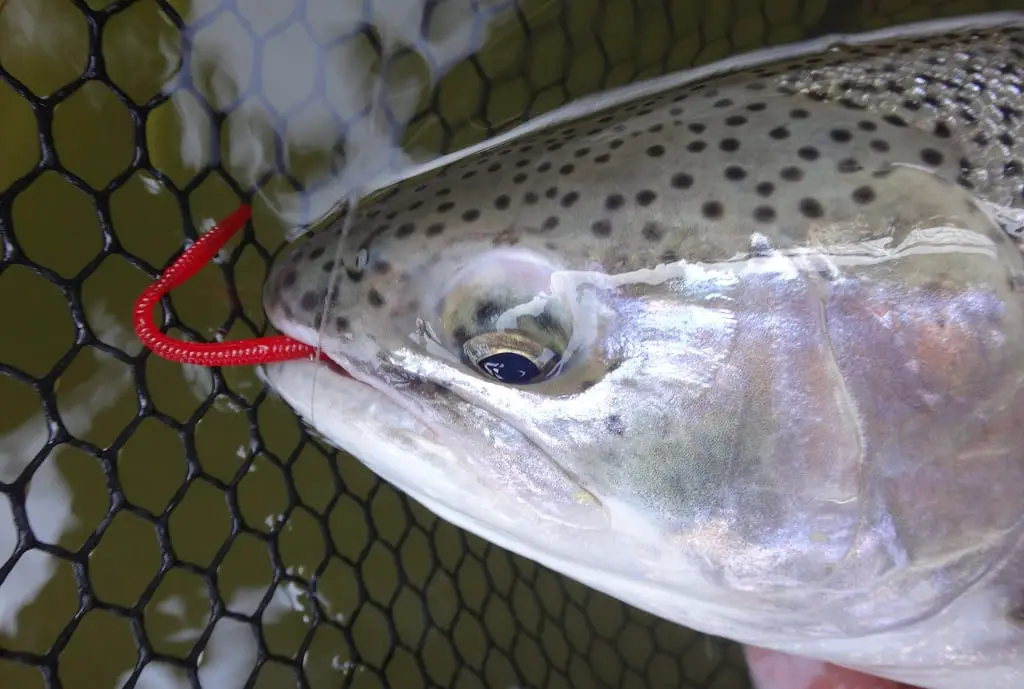
Fishing with worms for trout and steelhead is nothing new, but anglers now have many options regarding the type of worms available. I will provide advice from river guides like myself and our contributing river guides on which worms are best and how the guides uses them to catch more fish.
Anglers use dew worms, smaller garden worms, and plastic worms. You can use float fishing and bottom bouncing methods when worm fishing in rivers. Sometimes, plastic worms have advantages over live worms.
Fishing With Live Worms
Fishing with live worms can be very effective, especially after rains, in the spring, and early summer.
Most of the northern USA and Canada have an abundance of trout worms, and trout and steelhead rarely pass up a well-presented trout worm.
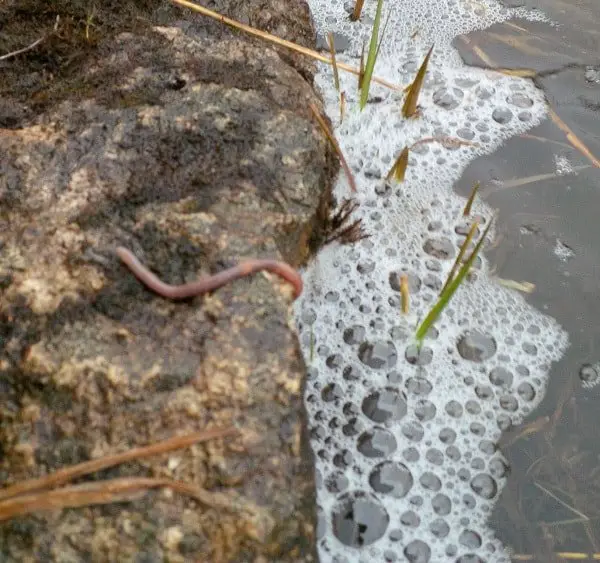
It’s no secret that trout and steelhead love worms. They are a big meal that is hard for them to pass up.
Worms will come up to the surface under heavy rains or after dark, and they will wander around on the surface.
Some will wander too close to the river’s edge and then fall into the river, where they will likely be eaten by the closest fish.
Fishing with live worms requires a little extra skill, and your setup, along with how you present the worm is important.
Live trout worms tend to fall off the hook if cast too hard, so a slow lob type of cast is required. To make sure the worm doesn’t fall off, some anglers will hook the worm multiple times so that the worm is almost in a ball but this is the wrong way to hook a worm. DO NOT DO THIS!
Hooking a worm into a ball or blob of worm is a big mistake since it’s not natural for a trout worm to drift down the river in a ball.
Every time I see a trout worm tumbling down the river, it is extended and long and not all curled up, and that is how the trout see them so that is how you need to fish them for the most success.
I always rig my worms by hooking them only once or twice through the fattest part of the worm so they look and drift more naturally, and I just adjust my cast so the trout worm doesn’t go flying off during the cast. This works great for me.
If you are not skilled enough to lob cast a real trout worm without it flying off all the time I highly recommend using a plastic worm.
Dew Worms For Fishing
Dew worms are those extra-long fat worms often sold at bait stores and gas stations. These can be good for trout and steelhead in rivers and lakes.
I will use dew worms in bigger rivers, in faster water, or when the water is dirtier or higher from rain. But I prefer to use the smaller garden-type worms in clear water.
Garden Worms For Fishing
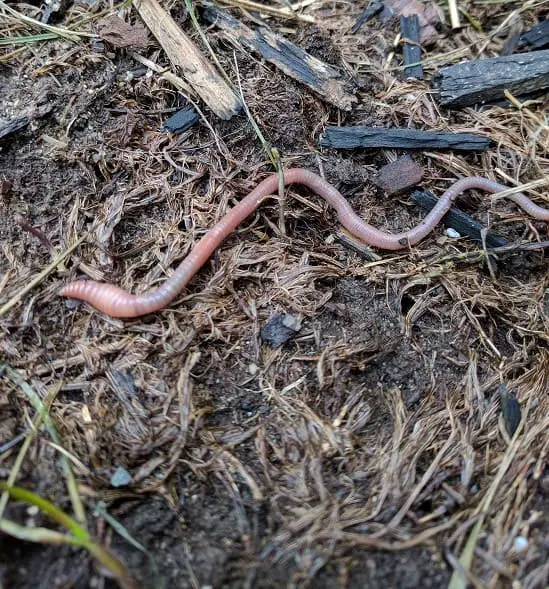
On smaller trout, an 8-inch long dew worm may be too big for them to get into their mouths, which means missed fish.
Some anglers call trout worms, red worms, or red wigglers.
These smaller worms are less intrusive, and the entire worm can fit into a trout’s mouth, which help with hook sets.
Smaller trout worms look more natural but are still a good-sized meal for a trout or steelhead. Even when fishing with worms for very large steelhead, my go-to size on worms is 3 to 4 inches long.
I’ll even use 2-inch worms when fishing for steelhead in the winter.
Because trout worms are much smaller, one hook through the fattest part of the worm with a slower lob cast works great.
Fishing With Plastic Worms
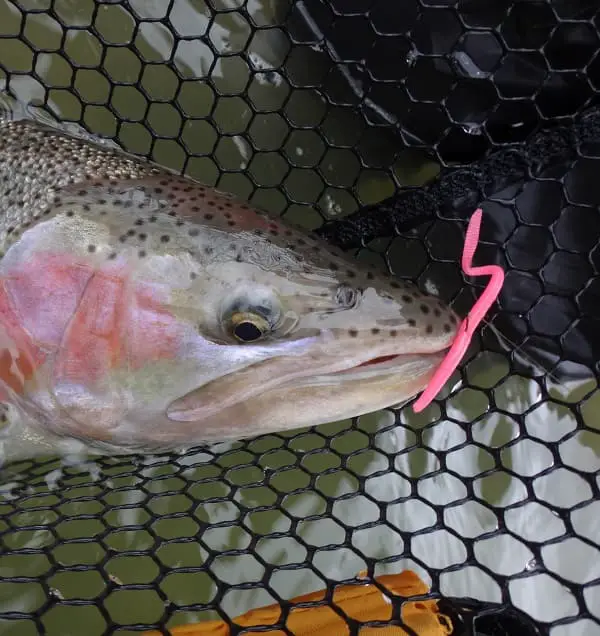
I catch a ton of trout and steelhead on plastic worms, and there are plenty of advantages to using plastic worms over live worms.
I have experimented many times with one of my clients fishing with live trout worms while l and another angler used a plastic worm, and the results were always the same: all anglers caught equal amounts of fish!
Plastic worms catch just as many trout and steelhead as live worms do under most river conditions.
Head guide Jordan from A Perfect Drift Guide Company just informed me that in December 2021, four-inch pink and red plastic worms were the first bait to go on the hook, and they almost always caught the most steelhead.
Jordan fishes with worms under a float using the same float leader that I use.
Plastic worms hold onto the hook better when cast hard, and plastic worms also don’t fall off on hard hook sets like real worms do. This means more time fishing, less time putting on new worms, and less time drifting an empty hook through the pool because your live worm fell off.
Another advantage of plastic worms is that they come in many different colors that can attract more fish. Some days, the pink worm is the best color, while other days, the red or brown worm will fish better.
I use the conditions to determine the size of the worm, which you can easily do with plastic worms.
If the water is very low and clear, I may use a two-inch worm, but under normal conditions or slightly off-colored water, I will use a three or 3.5-inch worm. For steelhead, I will sometimes try a 5″ to 6″ plastic worm as a last resort, or when no other bait is working, and sometimes this huge worm will work for a fish or two.
A little trick I have done with steelhead is to fish the pool with all the regular-sized baits and worms, and before I leave, I’ll make a few casts with a large 6-inch plastic worm or Dew Worm, which sometimes works and sometimes it doesn’t.
Plastic Worm Colors
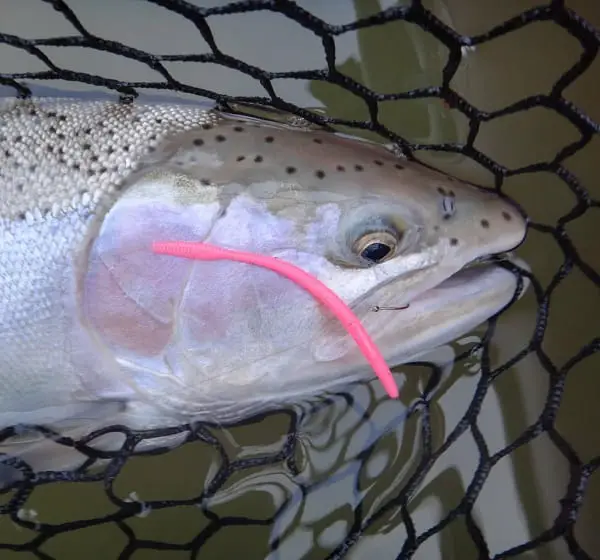
My most productive color in clear and off-colored water is the bubblegum pink worm. I have also done great with a natural brown worm and a red worm.
There are days when I catch more trout and steelhead on the red worm than other colors, so it’s always good to rotate through colors to see if one color worm is fishing better than others.
I have tried other colors like white, orange, chartreuse, and purple. I have had limited success with those colors except for a light purple color that I found that works very well for trout and steelhead.
My favorite brands of plastic worms are:
- Berkley PowerBait Floating Trout Worm 3” – Check prices at FishUSA.com or at BassPro Shops – HERE
- Mad River Worms – Check prices at FishUSA.com – HERE
- Raven Steelhead worms – Get them at FishHeadsCanada.net
Rubber Worms
Rubber worms are the exact same as plastic worms, although some anglers call them rubber worms and others call them plastic worms. Some fake worms, like Berkley GulpAlive Worms, are even made from an organic material that has a scent that trout might pick up on.
Hooks For Worms
I want my worms to drift naturally in the current, and I want a hook that allows the worm to do this. Hooks that are too big or too heavy will weigh your worm down and make it sink and drag across the bottom. Thats not a good place for a bait to be. A hook that is too big will also be seen by the fish.
I use different sizes depending on the size of the worm. For a big fat dew worm, I will use a larger hook, but for a smaller 3-inch plastic trout worm, I will use a smaller hook around size 10.
For plastic trout worms around three inches, try a size 12 Raven Specimen Hook or a size 10 Gamakatsu Hook.
I have an entire page on the best hooks and when and how to use them for trout and steelhead baits. Check out my page 4 Best Float Fishing Hooks
How To Rig A Worm
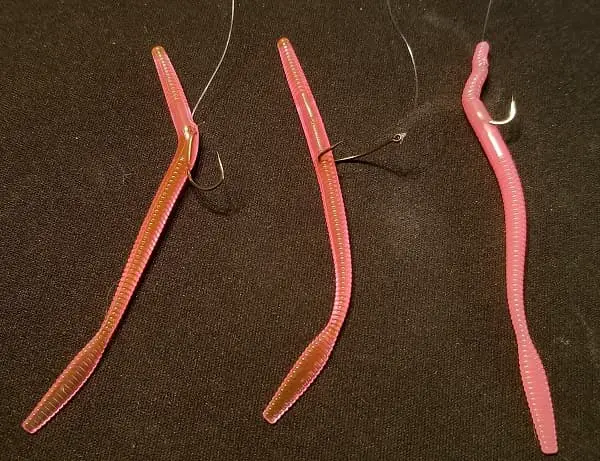
If you are going to be worm fishing, you need to know how to rig them up properly. A properly rigged and properly presented worm will always catch way more fish.
When guiding with worms, I have experimented with multiple ways of rigging up the worm, and the one I do the most is the one in the middle. This method is known as wacky rigging, and although you would think the fish might see the hook it doesn’t seem to matter.
These are three common ways to rig a worm. I rig live worms and plastic worms the same way. What you don’t want to do is bunch up the worm into a ball. Doing so will mean less or no fish.
When using plastic or rubber worms, I like them to have a little bit of action. I find a single hook through the middle of the worm gives the worm the most life-like action, and this is the method that I use the most for trout and steelhead. It’s also the easiest and fastest way to hook a live or plastic worm.
If I am worm fishing for very finicky trout, I will try to hide the kook more like in the picture on the right or on the left. The far left is easiest to rig and covers most of the worm, but it’s still in the middle, which provides more action to the worm.
Fishing For Trout With Worms
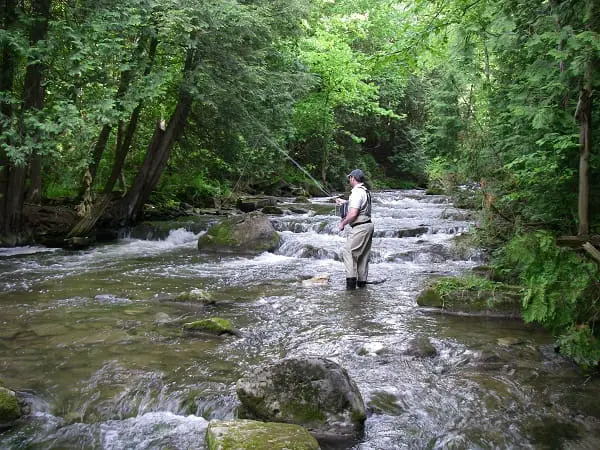
Fishing for trout with worms can be exceptionally effective, especially early in the morning and after big rains which get the worms active. When fishing for trout with worms I prefer worms from 2 inches to 4 inches.
Both big and small trout will pick up a well-presented worm that is drifted below a float or bottom bounced through a pool.
When fishing for trout with worms, I rig them up and fish them the same way that I fish worms for steelhead. The only thing I do differently is adjust and adapt my presentation to the spot that I am fishing.
Since many trout rivers are much smaller and have much smaller spots, the traditional float fishing method may not work as well.
My most productive method for fishing for trout with worms or even with any bait in low clear water is my advanced bottom bouncing method. This method is deadly on nervous trout and on big trout and is easy to fish with.
Fishing For Steelhead With Worms
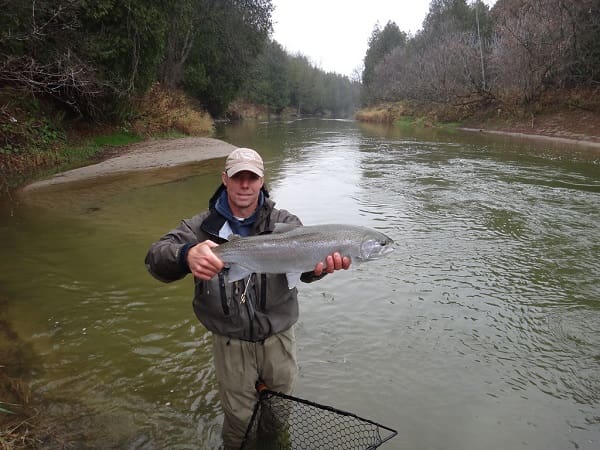
When fishing for steelhead with worms, I mostly use 3 to 4-inch plastic pink, red, or brown worms instead of a live worm and I will use the float fishing method.
Fishing for steelhead with worms is one of the most productive ways to catch steelhead.
I always run a worm through the pool before I move to the next pool, because most days, the worm will catch some steelhead that may not want to eat a spawn sack or a bead.
When fishing for steelhead with worms I will either drift the worm below a float or I will use a bottom bouncing method. For more information on float fishing, check out this page, Float Fishing: Tips From River Guides For More Trout
Sometimes, the best method when fishing for steelhead with worms in shallower or faster water is to use the bottom bounce method.
I use the same type of hooks that I use for spawn bags or beads. You can see my favorite hooks on my Best Hooks page.
Guide Tip: Worms tend to float or are neutral buoyancy, so I do not use worms when I’m trying to find the bottom, I will use a bait that sinks better, like a glass bead or a spawn bag.
Because worms tend to float, I will sometimes add a single BB and AB-sized split shot about 8 to 10 inches up from the worm to keep it down and in the strike zone.
Fishing Worms With A Fly Rod
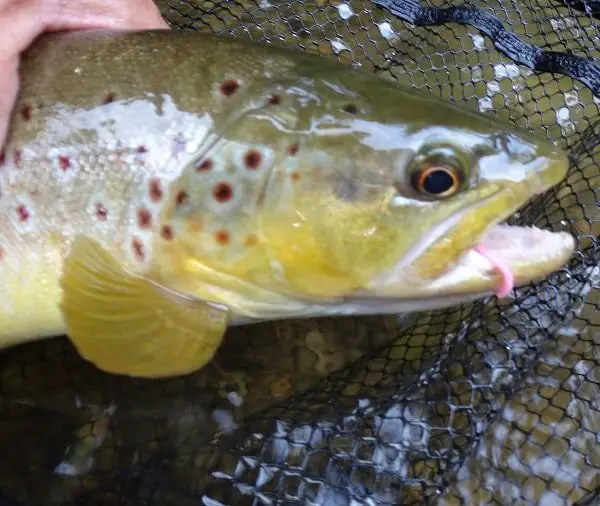
I have caught thousands of trout and steelhead using a worm fly pattern.
In the Great Lakes region, my steelhead worm fly has caught me more BIG trout and steelhead than any other fly.
I fish with worm flies the same way I fish with other subsurface flies.
Check out my best flies for steelhead page, which includes my favorite worm pattern, or visit my best flies for trout page.
Tight Lines
Graham

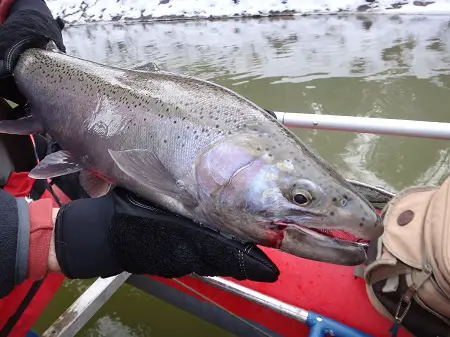
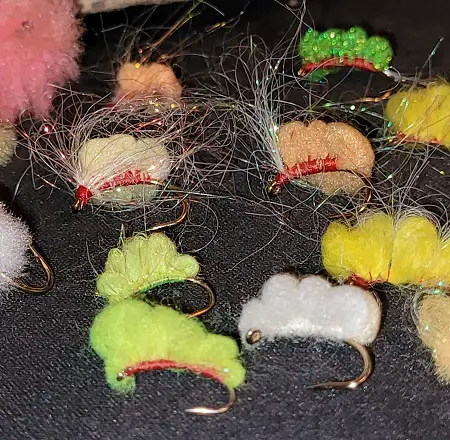
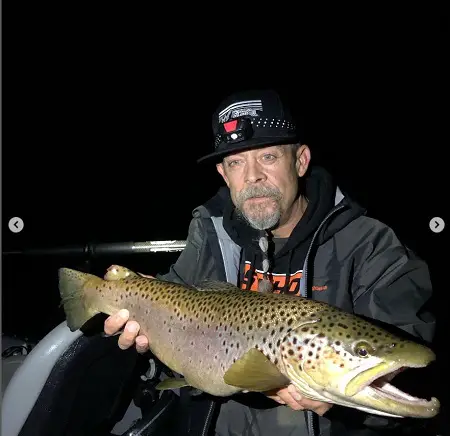
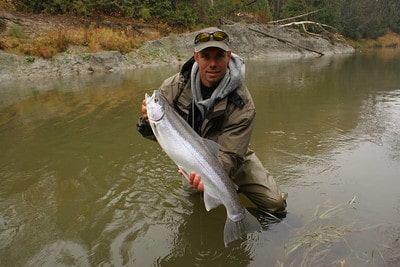
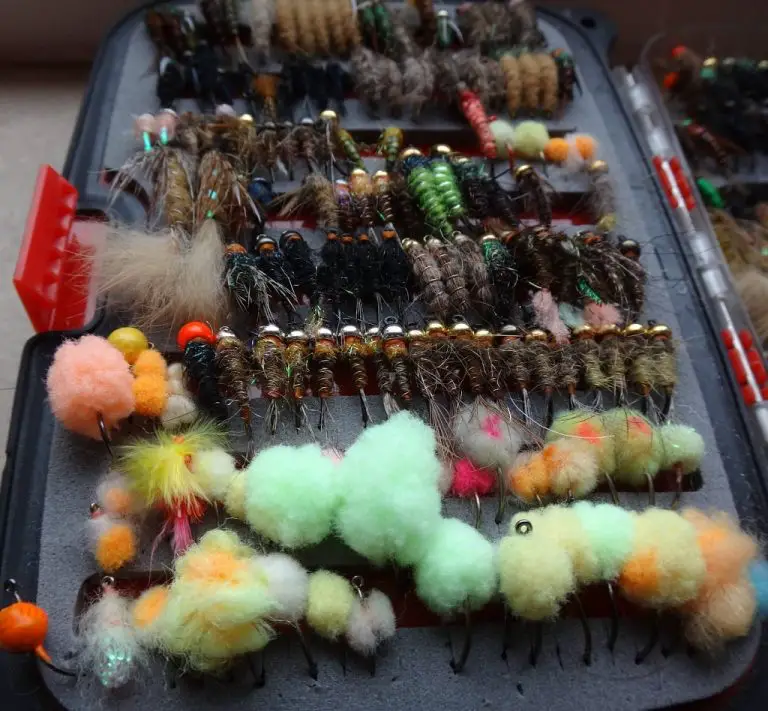
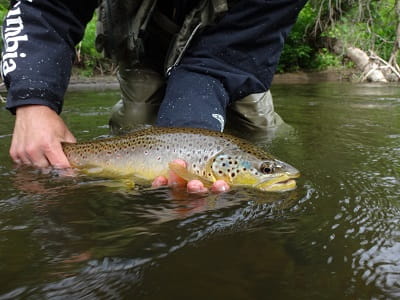
What size and type/brand of hook do you use for wacky rigging a 3inch Berkley Floating trout worm?
Hi John, I added a section above about the hooks to use. For plastic trout worms around 3 inches try a size 10 Raven Sedge Hook which are the ones in the section on rigging up worms or use a size 10 Gamakatsu Hook. For more detailed info go to the page on 4 Best Float Fishing Hooks. good luck.
Hey Graham, what size hook do you recommend for a large dew worm
Hi Even, a size 8 or 6 Raven Specimen hook should work. Hook it once through the clitellum ( the fat light colored bump) and get good at a lob-type cast.
Good Luck,
Graham
How long of rubber worm do you suggest for st head with 1/8 and 1/4 oz jig. Also length of worm for bottom bouncing and suggested hook size. THANKS RICHARD
Hey Richard
3 to 4-inch worms seem to work great for me with jigs and the same with floats or bottom bouncing. I mostly use size 8 and 10 wide gape hooks.
However, don’t tell anyone, but I have used 6-inch plastic dew worms with great success when other baits fail or I have drifted the smaller worms through with no action, and I will upsize my hook to a 4 or 6 for those big worms.
Graham
when fishing either lake or stream, should I use a leader line up to the hook, or tie directly onto my 6lb line directly? if so, how long should the leader be and what test line?
Hi Clinton,
I normally always add 16 to 24 inch 6 to 8 pound fluorocarbon leader, but factors such as size of fish, lure vs bait, speed of river or logs and boulders, and size of river will determine the size of the leader. It also depends on the size of your mainline, if you are only using 2 to 4 pound mainline then a leader is probably not needed so you can tie direct.
Graham
Graham, when fishing a rubber or plastic worm is it the same setup as floating an egg sac? Meaning the same leader setup as an egg sac. Thanks
Hey Brendon,
Yes, however, the only thing I sometimes change is, since the worm floats or is neutral buoyancy, I will sometimes add a small split shot 6 to 8 inches up from the worm to keep it down.
Otherwise, everything about the leader is the same.
Good luck,
Graham
Hi Graham,Mad river trout worms are unscented,what scent attractant you recommend for all plastic trout worms for spring,summer,fall and winter.This website is awesome,thank you for everything.
Hey Faruk,
Most of the time, I do not add scent to the worms. I’ve tried scent on worms but I’ve never found that it makes much of a difference.
Best of luck,
Graham
So what do I need to do to fly you into a remote lake and teach me how to catch these sneaky browns lol. Reading this has really helped me understand what I’ve been doing wrong, oh and I an ( or was ) “THAT GUY” whom balled the worm up . But seriously if your in the Ottawa area I have a float plane.
Hey Matt,
If you get everything correct, it makes it soooo much easier.
Best of luck
Graham